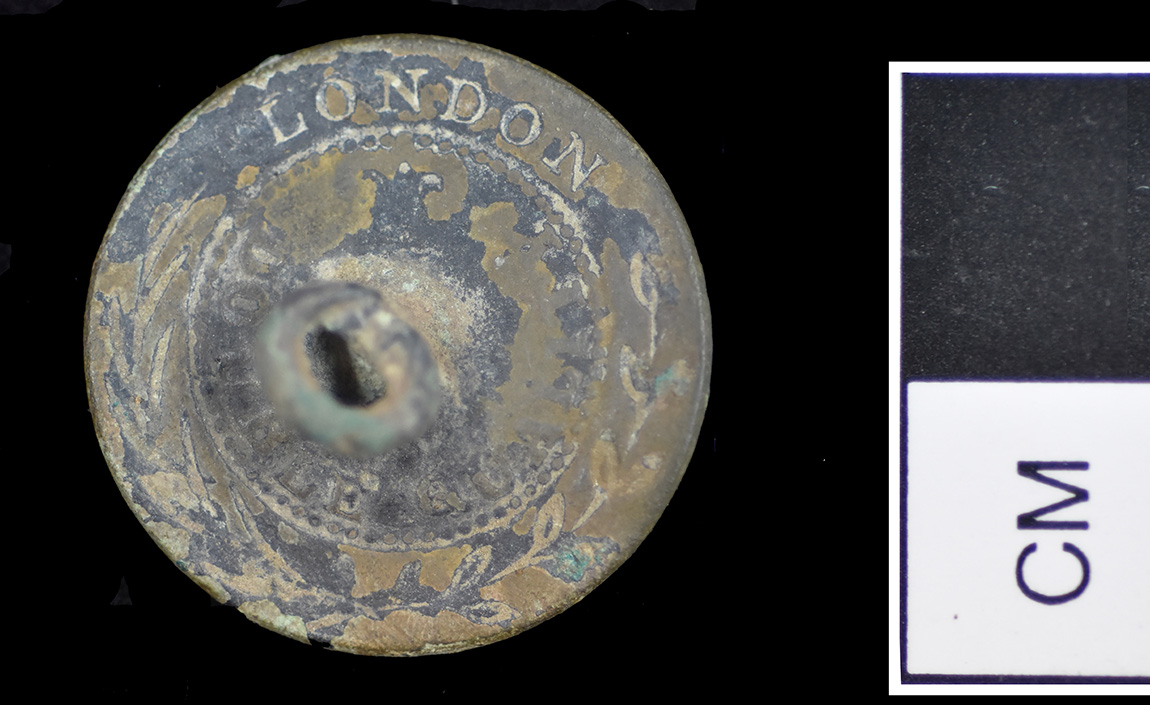Carl Drexler, Arkansas Archeological Survey – SAU Research Station
Artifact of the Month – February 2021
Our Artifact of the Month for February is a button… yes, a button. Stick with me, it’s a really fascinating button tied into a really interesting history. Let’s look a little closer. First, it’s made of brass and is 0.795” (20.2mm) across and 0.04” (1mm) thick. It weighs 0.1 ounces (2.6 grams). It is plain on its face, which is slightly bent and figured with green and brown areas of oxidation, a testimony to the time it spent in the dirt. The back (pictured) is much more ornate, with a set of impressed olive fronds terminating at the word “LONDON.” Inside these is a thin line; then, if you hold it to the light correctly, you can make out the words “DOUBLE” and “QUALITY,” a reference to the quality standards of the British button industry. At the center is a loop shank, where the thread used to sew the button onto the garment connected. English workers made this button by placing a brass disc in a die, then striking the die to create the impressions. Someone then brazed the wire shank into the center.
The late Claude McCrocklin, an avocational archeologist from Shreveport, Louisiana, recovered the button around 1990 from a site called Tara II, near the Red River in Miller County. He transferred his collection from the site, including this button, allowing us to curate it.
There are two things that really need to be appreciated about this find and its context. First, the button dates between about 1790 and 1820, which is just after the Revolutionary War. Though we had just fought for independence from the British, the United States carried on a massive amount of trade with the English in the postwar period. Many of our industries, including the button-making industry, were still fledgling, and it was our former foes who met demands for mass-produced goods. Second, and I may have been burying the lede here, this was not a button worn by an American (well, European-American) settler. You see, Tara II is one of the sites identified as being part of the Cherokee community established in the Lost Prairie area of what is now Miller County back in 1819. Pushed from their homelands back east, the Cherokees, led by Duwali (The Bowl), attempted to establish a new community here in southwest Arkansas. Troubles with non-native neighbors led to their violent expulsion the following year, but in the short time that they were here, the Cherokees left their mark on the landscape. This button, once worn by a Cherokee settler in southwest Arkansas, is part of that mark.
So, this small piece of rather mundane brass connects us to this brief occupation of what would become Miller County by people who were moving west, seeking a new homeland. It also underscores that globalization is not a new thing: the button was made on another continent and brought all the way to southwest Arkansas by ship, wagon, and foot before it was deposited in our soil.
Materials: Copper alloy (brass)
Dimensions: 20.2mm diameter, 1mm thick, 2.6 grams
Age Estimate: 1790-1820
Courtesy of: Arkansas Archeological Survey – Southern Arkansas University Research Station


